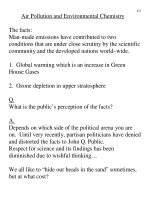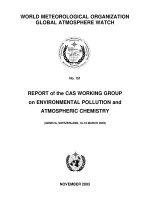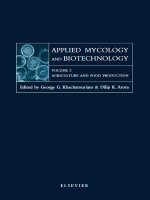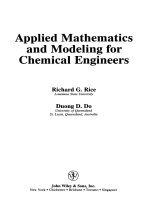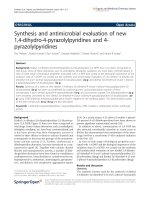Applied Surface and Colloid Chemistry
Bạn đang xem bản rút gọn của tài liệu. Xem và tải ngay bản đầy đủ của tài liệu tại đây (44.03 MB, 607 trang )
HANDBOOK OF APPLIED
SURFACE AND COLLOID
CHEMISTRY
Volume 1 - 2
Edited by
Krister Holmberg
Chalmers University of Technology,
Goteborg, Sweden
Associate Editors
Dinesh O. Shah
University of Florida,
USA
Milan J. Schwuger
Forschungszentrum JUlich GmbH,
Germany
JOHN WILEY & SONS, LTD
www.pdfgrip.com
Copyright © 2002 by John Wiley & Sons Ltd,
Baffins Lane, Chichester,
West Sussex PO19 IUD, England
National
01243 779777
International (+44) 1243 779777
e-mail (for orders and customer service enquiries):
Visit our Home Page on
or
All Rights Reserved. No part of this publication may be reproduced, stored in a retrieval
system, or transmitted, in any form or by any means, electronic, mechanical, photocopying,
recording, scanning or otherwise, except under the terms of the Copyright, Designs and Patents Act
1988 or under the terms of a licence issued by the Copyright Licensing Agency Ltd, 90
Tottenham Court Road, London, UK WlP OLP, without the permission in writing of the
publisher and the copyright holder.
Other Wiley Editorial Offices
John Wiley & Sons, Inc., 605 Third Avenue,
New York, NY 10158-0012, USA
Wiley-VCH GmbH, Pappelallee 3,
D-69469 Weinheim, Germany
John Wiley & Sons Australia Ltd, 33 Park Road, Milton,
Queensland 4064, Australia
John Wiley & Sons (Asia) Pte Ltd, 2 Clementi Loop #02-01,
Jin Xing Distripark, Singapore 0512
John Wiley & Sons (Canada) Ltd, 22 Worcester Road,
Rexdale, Ontario M9W ILl, Canada
Library of Congress Cataloging-in-Publication Data
Handbook of applied surface and colloid chemistry / edited by Krister Holmberg.
p.cm.
Includes bibliographical references and index.
ISBN 0-471-49083-0 (alk. paper)
1. Chemistry, Technical. 2. Surface chemistry. 3. Colloids. I. Holmberg, Krister, 1946TP149 .H283 2001
660 - dc21
2001024347
British Library Cataloguing in Publication Data
A catalogue record for this book is available from the British Library
ISBN 0-471-49083-0
Typeset in 9/1 lpt Times Roman by Laser Words Pvt. Ltd., Chennai, India.
Printed and bound in Great Britain by Antony Rowe Ltd. Chippenham, Wiltshire.
This book is printed on acid-free paper responsibly manufactured from sustainable forestry, in which at least two trees are planted
for each one used for paper production.
www.pdfgrip.com
Contributors List
Joshua J. Adler
John Daicic
Department of Materials Science and Engineering, and
Engineering Research Center for Particle Science and
Technology, PO Box 116135, University of Florida,
Gainesville, FL-32611, USA
Institute for Surface Chemistry, PO Box 5607, SE-114
86 Stockholm, Sweden
Dennis S. Everhart
Kimberly Clark Corporation, 1400, Holcombe Bridge
Road, Roswell, GA-30076-2199, USA
Bjorn Bergenstahl
Department of Food Technology, Center for Chemistry
and Chemical Engineering, Lund University, PO Box
124, SE-221 00 Lund, Sweden
Vance Bergeron
Ecole Normale Superieure, Laboratorie de Physique
Statistique, 24 Rue Lhomond 75231, Paris CEDEX 05,
France
Lennart Bergstrom
Valentin B. Fainerman
International Medical Physicochemical Centre, Donetsk
Medical University, 16 Hych Avenue, Donetsk 340003,
Ukraine
Michele Ferrari
CNR - Instituto di Chimica Fisica Applicata dei Materiali, Via De Marini 6, 1-16149 Genova, Italy
Institute for Surface Chemistry, PO Box 5607, SE-114
86 Stockholm, Sweden
David T. Floyd
Michal Borkovec
Degussa-Goldschmidt Care Specialties, PO Box 1299,
914, East Randolph Road, Hopewell, VA-23860, USA
Department of Inorganic, Analytical and Applied Chemistry, CABE, University of Geneva, Sciences II, 30 quai
Ernest Ansermet, CH-1211 Geneva 4, Switzerland
Johan Froberg
Institute for Surface Chemistry, PO Box 5607, SE-114
86 Stockholm, Sweden
Norman L. Burns
Amersham Pharmacia Biotech, 928 East Arques Avenue,
Sunnyvale, CA 94085-4520, USA
Per M. Claesson
Department of Chemistry, Surface Chemistry, Royal
Institute of Technology, SE-100 44 Stockholm, Sweden
and Institute for Surface Chemistry, PO Box 5607, SE114 86 Stockholm, Sweden
Burghard Gruening
Degussa-Goldschmidt Care Specialties, Goldschmidtstrasse 100, D-45127 Essen, Germany
Karina Grundke
Institute of Polymer Research Dresden, Hohe Strasse 6,
D-01069 Dresden, Germany
Michael F. Cox
Syed Hassan
Sasol North America, Inc., PO Box 200135, 12024 Vista
Parke Drive, Austin, TX-78726, USA
Department of Chemical Engineering, UMIST, PO Box
88, Manchester, M60 IQD, UK
www.pdfgrip.com
Heinz Hoffmann
Bjorn Lindman
Lehrstuhl fur Physikalische Chemie I der Universitat
Bayreuth, Universitatsstrasse 30, D-95447 Bayreuth,
Germany
Department of Physical Chemistry 1, Chemical Center,
Lund University, PO Box 124, SE-221 00 Lund, Sweden
Krister Holmberg
Department of Organic Chemistry, University of Florence, Via G. Capponi 9, 50121 Florence, Italy
Giuseppe Loglio
Department of Applied Surface Chemistry, Chalmers
University of Technology, SE-412 96 Goteborg, Sweden
James J. Lu
Lothar Huber
Adam Bergstrasse IB, D-81735 Munchen, Germany
Paul D. T. Huibers
Department of Chemical Engineering, Massachusetts
Institute of Technology, Cambridge, MA 02139-4307,
USA
Stephen T. Hyde
Applied Mathematics Department, Research School
of Physical Sciences, Australia National University,
Canberra 0200, Australia
James R. Kanicky
Center for Surface Science and Engineering, Departments of Chemical Engineering and Anesthesiology, PO
Box 116005, University of Florida, Gainesville, FL32611,USA
Bengt Kronberg
Institute for Surface Chemistry, PO Box 5607, SE-114
86 Stockholm, Sweden
Hubert Kuhn
Department of Physical Chemistry, University of Essen,
Universitaetsstrasse 3 - 5 , D-45141 Essen, Germany
Markus Lade
Institute for Technical Chemistry, Technical University
of Berlin, Sekr. TC 8, Strasse der 17 Juni 124, D-10623
Berlin, Germany
Department of Mechanical and Industrial Engineering,
Univeristy of Toronto, 5 King's College Road, M5S 3G8
Toronto, Ontario, Canada
Alexander V. Makievski
International Medical Physicochemical Centre, Donetsk
Medical University, 16 Ilych Avenue, Donetsk 340003,
Ukraine
Martin Malmsten
Institute for Surface Chemistry and Royal Institute
of Technology, PO Box 5607, SE-114 86 Stockholm,
Sweden
Anna Matero
Institute for Surface Chemistry, PO Box 5607, SE-114
86 Stockholm, Sweden
Reinhard Miller
Max-Planck-Institute of Colloids and Interfaces, Am
Mtihlenberg, D-14476 GoIm, Germany
Helmuth Mohwald
Max-Planck-Institute of Colloids and Interfaces, Am
Miihlenberg, D-14476 GoIm, Germany
Juan-Carlos Lopez-Montilla
Center for Surface Science and Engineering, Departments of Chemical Engineering and Anesthesiology, PO
Box 116005, University of Florida, Gainesville, FL32611,USA
Hubert Motschmann
Oliver Lade
Institute for Physical Chemistry, University of Cologne,
Luxemburger Strasse 116, D-50939 Cologne, Germany
Max-Planck-Institute of Colloids and Intefaces, Am
Miihlenberg, D-14476 GoIm, Germany
Brij M. Moudgil
C. N. Catherine Lam
Department of Mechanical and Industrial Engineering,
University of Toronto, 5 King's College Road, M5S 3G8
Toronto, Ontario, Canada
Department of Materials Science and Engineering, and
Engineering Research Center for Particle Science and
Technology, PO Box 116135, University of Florida,
Gainesville, FL-32611, USA
www.pdfgrip.com
Michael Mulqueen
Mark W. Rutland
Department of Chemical Engineering, Massachusetts
Institute of Technology, Cambridge, MA 02139-4307,
USA
Department of Chemistry, Surface Chemistry, Royal
Institute of Technology, SE-100 44 Stockholm, Sweden
and Institute for Surface Chemistry, PO Box 5607, SE114 86 Stockholm, Sweden
A. Wilhelm Neumann
Department of Mechanical and Industrial Engineering,
University of Toronto, 5 King's College Road, M5S 3G8
Toronto, Ontario, Canada
Lutz Nitschke
Karwendelstrasse 47, D-85560 Ebersberg, Germany
Magnus Nyden
Department of Applied Surface Chemistry, Chalmers
University of Technology, SE-412 96 Goteburg, Sweden
UIf Olsson
Department of Physical Chemistry 1, Center for Chemistry and Chemical Engineering, PO Box 124, S-221 00
Lund, Sweden
Wolfgang von Rybinski
Henkel KgaA, Henkelstrasse 67, D-40191 Dusseldorf,
Germany
Antje Schmalstieg
Thaerstrasse 23, D-10249 Berlin, Germany
Reinhard Schomacker
Institute for Technical Chemistry, Technical University
of Berlin, Sekr. TC 8, Strasse des 17 Juni 124, D-10623
Berlin, Germany
Christoph Schunicht
Degussa-Goldschmidt Care Specialties, Goldschmidstrasse 100, D-45127 Essen, Germany
Samir Pandey
Center for Surface Science and Engineering, Departments of Chemical Engineering and Anesthesiology, PO
Box 116005, University of Florida, Gainesville, FL32611,USA
Dinesh O. Shah
Center for Surface Science and Engineering, Departments of Chemical Engineering and Anesthesiology, PO
Box 116005, University of Florida, Gainesville, FL32611,USA
Alexander Patist
Cargill Inc., Central Research, 2301 Crosby Road,
Wayzata, MN-55391, USA
Robert J. Pugh
Institute for Surface Chemistry, PO Box 5607, SE-114
86 Stockholm, Sweden
Pankaj K. Singh
Department of Materials Science and Engineering, and
Engineering Research Center for Particle Science and
Technology, PO Box 116135, University of Florida,
Gainesville, FL-32611, USA
Dale S. Steichen
Heinz Rehage
Department of Physical Chemistry, University of Essen,
Universitaetsstrasse 3 - 5 , D-45141 Essen, Germany
Akzo Nobel Surface Chemistry AB, SE-444 85 Stenungsund, Sweden
Tharwat F. Tadros
Brian H. Robinson
School of Chemical Sciences, University of East Anglia,
Norwich, Norfolk, NR4 7TJ, UK
89, Nash Grove Lane, Wokingham, Berkshire, RG40
4HE, UK
Klaus Tauer
Madeleine Rogerson
School of Chemical Sciences, University of East Anglia,
Norwich, Norfolk, NR4 7TJ, UK
Max Planck Institute of Colloids and Interfaces, D14424 GoIm, Germany
William Rowe
Fabienne Testard
Department of Chemical Engineering, UMIST, PO Box
88, Manchester, M60 IQD, UK
Service de Chemie Moleculaire, CE Saclay, Batelle 125,
F-999 91 Gif-sur-Yvette, France
www.pdfgrip.com
Staffan Wall
John Texter
Strider Research Corporation, 265 Clover
Rochester, NY 14610-2246, USA
Street,
Department of Chemistry, Physical Chemistry, Goteborg
Universitet, SE-412 96 Goteborg, Sweden
Fredrik Tiberg
Guenther W. Wasow
Institute for Surface Chemistry, PO Box 5607, SE-114
86 Stockholm, Sweden
Karl-Marx-Alle 133, D-10243 Berlin, Germany
Klaus Wormuth
Gordon J. T. Tiddy
Department of Chemical Engineering, UMIST, PO Box
88, Manchester, M60 IQD, UK
Werner Ulbricht
Lehrstuhl flir Physikalische Chemie I der Universitat
Bayreuth, Universitatsstrasse 30, D-95447 Bayreuth,
Germany
Institute for Technical Chemistry, Technical University
of Berlin, Sekr. TC 8, Strasse des 17 Juni 124, D-10623
Berlin, Germany
Thomas Zemb
Service de Chemie Moleculaire, CE Saclay, Batelle 125,
F-999 91 Gif-sur-Yvette, France
www.pdfgrip.com
Foreword
I am delighted to have been given the opportunity to
write a Foreword for this important, landmark book in
Surface and Colloid Chemistry. It is the first major book
of its kind to review, in such a wide-ranging and comprehensive manner, the more technical, applied aspects
of the subject. Yet it does not skip the fundamentals. It
would have been wrong to have done so. After all, chemical technology is the application of chemical knowledge
to produce new products and processes, and to control
better existing ones. One cannot achieve these objectives without a thorough understanding of the relevant
fundamentals. An attractive feature of this book is that
the author of each chapter has been given the freedom to present, as he/she sees fit, the spectrum of the
relevant science, from pure to applied, in his/her particular topic. Of course this approach inevitably leads
to some overlap and repetition in different chapters, but
that does not necessarily matter. Fortunately, the editor
has not taken a "hard-line" on this. This arrangement
should be extremely useful to the reader (even if it
makes the book look longer), since one does not have
to search around in different chapters for various bits of
related information. Furthermore, any author will naturally have his own views on, and approach to, a specific
topic, moulded by his own experience. It is often useful
for someone else, particularly a newcomer, wanting to
research a particular topic, to have different approaches
presented to them. (There is no absolute truth in science, only commonly accepted wisdom!). For example,
someone primarily interested in learning about the roles
that surfactants or polymers play in formulating a pharmaceutical product, might well gain from also reading
about this in a chapter of agrochemicals, or food detergents. Alternatively, someone wishing to learn about
paper making technology might also benefit from delving into the chapter on paints. It is very useful to have all
this information together in one source. Of course, there
are, inevitably, some gaps. The editor himself points out
the absence of a comprehensive chapter on emulsions,
for example, but to have covered every nook and cranny
of this field would be an impossible task, and have taken
forever to achieve! A refreshing feature of this book is
its timeliness.
The book will be of tremendous use, not only to
those working on industrial research and development,
over a whole range of different technologies which are
concerned with surface and colloid chemistry, but also
to academic scientists in the field, a major proportion
of whom interact very strongly with their industrial colleagues. It will compliment very well, existing textbooks
in surface and colloid science, which, in general, take
the more traditional approach of reviewing systematically the fundamental (pure) aspects of the subject, and
add in a few examples of applications, by a way of
illustration.
I personally will find this book an extremely useful
teaching aid, and I am certain many of my colleagues
and universities (particularly at post-graduate level), but
also to an activity more and more of us in the field
are becoming involved in, namely presenting various
aspects of surface and colloid science to industrialists, at
a specialist schools, workshops, awareness forums, etc.
I believe that Krister Holmberg was the ideal choice
to have edited this book. Not only does he have a
wide experience of different aspects of the field, but
he has successively worked in Industry, been Director of an internationally recognised research institute
(The Ytkemiska Institutet - The Institute for Surface
Chemistry - in Stockholm), and is now heading up the
Department of Applied Surface Chemistry at Chalmers
University of Technology. He has done an outstanding
job in putting this book together, and has produced an
extremely valuable reference source for all of us working with surfaces and colloids.
Brian Vincent
Leverhulme Professor of Physical Chemistry and
Director of The Bristol Colloid Centre
School of Chemistry, University of Bristol
BS8 ITS, UK
www.pdfgrip.com
Preface
This book is intended as a comprehensive reference
work on surface and colloid chemistry. Its title, "Handbook of Applied Surface and Colloid Chemistry",
implies that the book is practically oriented rather than
theoretical. However, most chapters treat the topic in a
rather thorough manner and commercial aspects, related
to specific products, etc. are normally not included. All
chapters are up-to-date and all have been written for the
specific purpose of being chapters in the "Handbook".
As will be apparent to the user, the many topics of the
book have been covered in a comprehensive way. Taken
together, the chapters constitute an enormous wealth of
surface and colloid chemistry knowledge and the book
should be regarded as a rich source of information,
arranged in a way that I hope the reader will find useful.
When it comes to the important but difficult issues
of scope and limitations, there is one clear-cut borderline. The "Handbook" covers "wet" but not "dry" surface chemistry. This means that important applications
of dry surface chemistry, such as heterogeneous catalysis involving gases, and important vacuum analysis
techniques, such as Electron Spectroscopy for Chemical
Analysis (ESCA) and Selected-Ion Mass Spectrometry
(SIMS), are not included. Within the domain of wet surface chemistry, on the other hand, the aim has been to
have the most important applications, phenomena and
analytical techniques included.
The book contains 45 chapters. The intention has
been to cover all practical aspects of surface and
colloid chemistry. For convenience the content material
is divided into five parts.
Part One, Surface Chemistry in Important Technologies, deals with a selected number of applications of surface chemistry. The 11 chapters cover a broad range of
industrial and household uses, from life-science-related
applications such as Pharmaceuticals and food, via detergency, agriculture, photography and paints, to industrial
processes such as paper-making, emulsion polymerization, ceramics processing, mineral processing, and oil
production. There are several more areas in which surface chemistry plays a role and many more chapters
could have been added. The number of pages are limited, however, and the present topics were deemed to
be the most important. Other editors may have made a
different choice.
Part Two, Surfactants, contains chapters on the four
major classes of surfactants, i.e. anionics, nonionics,
cationics and zwitterionics, as well as chapters on
polymeric surfactants, hydrotropes and novel surfactants. The physico-chemical properties of surfactants and
properties of liquid crystalline phases are the topics of
two comprehensive chapters. The industrially important
areas of surfactant-polymer systems and environmental
aspects of surfactants are treated in some detail. Finally,
one chapter is devoted to computer simulations of surfactant systems.
Part Three, Colloidal Systems and Layer Structures
at Surfaces, treats four important colloidal systems, i.e.
solid dispersions (suspensions), foams, vesicles and liposomes, and microemulsions. A chapter on emulsions
should also have been included here but was never
written. However, Chapter 8, Surface Chemistry in the
Polymerization of Emulsion, gives a rather thorough
treatment of emulsions in general, while Chapter 24,
Solid Dispersions, provides a good background to colloidal stability, which to a large part is also relevant to
emulsions. Taken together, these two chapters can be
used as a reference to the field of emulsions. Part Three
also contains chapters on two important layer systems,
i.e. Langmuir-Blodgett films and self-assembled monolayers.
Part Four, Phenomena in Surface Chemistry, consists
of extensive reviews of the important phenomena of
foam breaking, solubilization, rheological effects of
surfactants, and wetting, spreading and penetration.
Part Five, Analysis and Characterization in Surface
Chemistry, concerns a selected number of experimental
techniques. As with the selection of topics that make up
Part One, this list of 12 chapters could have been longer
and another editor may have made a different choice of
topics within the given number of chapters. However,
the experimental methods chosen are all important and I
hope that the way this part is organized will prove useful.
www.pdfgrip.com
Most books related to analysis and characterization
are divided into chapters on different techniques, such
as "Fluorescence" or "Self-diffusion NMR", i.e. the
division is by method. By contrast, the division here
is by problem. As an example, when the reader wants
to find out how to best measure micelle size he (or
she) does not need to know from the beginning which
methods to consider. The reader can go directly to
Chapter 38, Measuring Micelle Shape and Size, where
the relevant information is collected.
All 45 chapters can be regarded as overview articles. They all cover the area in a broad way and in
addition they often give in-depth information on specific sub-areas which the author has considered particularly important. Each chapter also gives references
to literature sources for those who need deeper penetration into the area. Each of the chapters is written
as a separate entity, meant to stand on its own. This
means that each chapter can be read separately. However, those knowledgeable in the field know that the
topics of the "Handbook" chapters are not isolated.
For example, there are obviously many connections
between Chapter 25, Foams and Foaming, and Chapter 31, Foam Breaking in Aqueous Systems, Chapter 27,
Micro emulsions, has much in common with both Chapter 32, Solubilization, and Chapter 40, Characterization
of Microemulsion Structure, while Chapter 19, Physicochemical Properties of Surfactants, deals among many
other things with lyotropic liquid crystals which is
the topic of Chapter 21 and which has strong links
to Chapter 39, Identification of Lyotropic Liquid Crystalline Mesophases. Such connections will lead to some
overlap. However, this is natural and should not present
any problem. First, a certain overlap is unavoidable if
each chapter is to be an independent entity. Secondly,
different authors will treat a particular topic differently
and these different views can often complement each
other. Since both of these aspects are helpful to the
reader, small overlaps have not been a concern for the
editor.
The "Handbook of Applied Surface and Colloid
Chemistry" is unique in scope and the only work of
its kind in the field of surface and colloid chemistry.
There exist comprehensive and up-to-date books lean-
ing towards the fundamental side of surface chemistry,
with Hans Lyklema's "Fundamentals of Interface and
Colloid Science" being one good example. There are
excellent books on surfactants and there are good textbooks on surface chemistry in general, such as "The
Colloidal Domain" by Fennell Evans and Hakan Wennerstrom and "Surfactants and Interfacial Phenomena"
by Milton Rosen. However, there exists no substantial
work like the "Handbook of Applied Surface and Colloid Chemistry" which covers applied surface chemistry
in a broad sense. Against this background, one may say
that the book fills a gap. I hope therefore that the "Handbook" will soon establish itself as an important reference
work for researchers both in industry and in academia.
I am grateful to my co-editors, Milan Schwuger of
Forschungzentrum Julich and Dinesh O. Shah from the
University of Florida for helping me to identify the
chapter authors. We, the editors, are extremely pleased
that we have managed to raise such an interest for
the project within the surface chemistry community.
Almost all of those that we approached expressed a
willingness to contribute and the result has been that the
contributors of the "Handbook" are all leading experts
in their respective fields. This is the best guarantee for
a balanced treatment of the topic and for an up-to-date
content.
On behalf of the entire editorial team, I would like
to thank all those who contributed as chapter authors.
Four persons, Bjorn Lindman, Robert Pugh, Tharwat
Tadros and Krister Holmberg, have written two chapters
each. The rest of the 45 chapters have been written by
different individual authors. In total 70 individuals from
10 countries contributed to the work. I hope that when
they see the "Handbook" in print they will regard the
result to be worth the effort. Finally, I would like to
thank Dr David Hughes at Wiley (Chichester, UK) for
his constant encouragement and patience.
www.pdfgrip.com
Krister Holmberg
Chalmers University of Technology
Sweden
Goteborg, January 2001
Contents
Contributors List .................................................................................................
ix
Foreword ............................................................................................................
xiii
Preface ...............................................................................................................
xv
Part I. Surface Chemistry in Important Technologies
1. Surface Chemistry in Pharmacy ...........................................................................
3
1.1
Introduction ...............................................................................................
3
1.2
Surface Activity of Drugs ...........................................................................
4
1.3
Effects of Drug Surface Activity on Formulation Structure and
Stability ......................................................................................................
6
1.4
Drug Delivery through Dispersed Colloidal Systems .................................
8
1.5
Drug Delivery through Thermodynamically Stable Systems .....................
15
1.6
Responsive Systems .................................................................................
24
1.7
Biodegradable Systems ............................................................................
26
1.8
Acknowledgements ...................................................................................
30
1.9
References ................................................................................................
30
2. Surface Chemistry in Food and Feed ...................................................................
39
2.1
Introduction ...............................................................................................
39
2.2
Colloids in Liquids .....................................................................................
39
2.3
Interparticle Interactions in Liquids ............................................................
42
2.4
Surface-Active Components .....................................................................
44
2.5
Particles and Surfaces in Air .....................................................................
48
2.6
Concluding Remarks .................................................................................
51
2.7
References ................................................................................................
51
v
www.pdfgrip.com
vi
Contents
3. Surface Chemistry in Detergency .........................................................................
53
3.1
Introduction ...............................................................................................
53
3.2
Surface Tension and Wetting ....................................................................
54
3.3
Adsorption at the Solid/Liquid Interface ....................................................
58
3.4
Complexation and Ion Exchange ..............................................................
61
3.5
Liquid/Liquid Interface ...............................................................................
65
3.6
Phase Behaviour of Surfactant Systems ...................................................
67
3.7
Foaming ....................................................................................................
71
3.8
References ................................................................................................
72
4. Surface Chemistry in Agriculture .........................................................................
73
4.1
Introduction ...............................................................................................
73
4.2
Surface Chemistry in Emulsifiable Concentrates ......................................
74
4.3
Surface Chemistry of Emulsion Concentrates ...........................................
76
4.4
Surface Chemistry in Suspension Concentrates .......................................
78
4.5
Surface Chemistry in the Application of Agrochemical Formulations ........
80
4.6
References ................................................................................................
83
5. Surface and Colloid Chemistry in Photographic Technology ...........................
85
5.1
Introduction ...............................................................................................
85
5.2
Surfaces and Particles in Photographic Technology .................................
90
5.3
Particles and Colloids in Photographic Technology ..................................
94
5.4
Coupler Dispersions ..................................................................................
99
5.5
Adsorber Dyes and Filter Dyes .................................................................
101
5.6
Matte Beads ..............................................................................................
103
5.7
References ................................................................................................
104
6. Surface Chemistry in Paints ..................................................................................
105
6.1
Introduction ...............................................................................................
105
6.2
Competitive Adsorption of Surfactants ......................................................
105
6.3
The Binder-Emulsion Preparation and Film Formation .............................
107
6.4
Pigment Dispersant ...................................................................................
113
6.5
Wetting of the Substrate ............................................................................
119
6.6
Use of Speciality Surfactants ....................................................................
121
6.7
Bibliography ..............................................................................................
122
www.pdfgrip.com
Contents
vii
7. Surface Chemistry of Paper ...................................................................................
123
7.1
Introduction ...............................................................................................
124
7.2
Fibre Properties .........................................................................................
125
7.3
Paper Formation .......................................................................................
128
7.4
Internal Sizing of Paper .............................................................................
138
7.5
Dry and Wet Strength of Paper .................................................................
145
7.6
Surface Treatment of Paper ......................................................................
146
7.7
Wettability and Absorbency of Paper ........................................................
154
7.8
Characterization of Paper Properties ........................................................
162
7.9
Acknowledgements ...................................................................................
171
7.10
References ................................................................................................
171
8. Surface Chemistry in the Polymerization of Emulsion .......................................
175
8.1
Introduction ...............................................................................................
175
8.2
A Little Relevant Thermodynamics ...........................................................
176
8.3
Emulsification ............................................................................................
179
8.4
Stability of Emulsions ................................................................................
186
8.5
Comminution or Condensation Techniques-What Makes the
Difference? ................................................................................................
190
8.6
Polymerization of (or in) Monomer Emulsions ...........................................
191
8.7
Fixation of an Emulsion by Radical Polymerization in Aqueous
Media-Fact or Fancy? ...............................................................................
196
References ................................................................................................
198
9. Colloidal Processing of Ceramics ........................................................................
201
8.8
9.1
Introduction ...............................................................................................
201
9.2
Powder Processing of Ceramics ...............................................................
202
9.3
Interparticle Forces and Colloidal Stability ................................................
203
9.4
Deagglomeration and Dispersion ..............................................................
206
9.5
Rheological Properties of Ceramic Suspensions ......................................
208
9.6
Consolidation ............................................................................................
212
9.7
Drying and Binder Burnout ........................................................................
216
9.8
Acknowledgements ...................................................................................
217
9.9
References ................................................................................................
217
www.pdfgrip.com
viii
Contents
10. Surface Chemistry in Dispersion, Flocculation and Flotation .......................... 219
10.1
Introduction ...............................................................................................
219
10.2
Surface Chemistry .....................................................................................
220
10.3
The Electrical Double-Layer ......................................................................
222
10.4
Zeta Potential (Electrokinetic Potential) ....................................................
224
10.5
Electrostatic Forces ...................................................................................
226
10.6
Manipulating Surface Behaviour by Polymer Adsorption ..........................
229
10.7
Manipulating Surface Behaviour by Surfactant Adsorption .......................
232
10.8
Particle Processing ...................................................................................
238
10.9
References ................................................................................................
249
11. Surface Chemistry in the Petroleum Industry .....................................................
251
11.1
Introduction ...............................................................................................
251
11.2
Fundamentals ...........................................................................................
252
11.3
Applications ...............................................................................................
259
11.4
Summary ...................................................................................................
266
11.5
References ................................................................................................
266
Part II. Surfactants
12. Anionic Surfactants ................................................................................................
271
12.1
Introduction ...............................................................................................
271
12.2
Soap ..........................................................................................................
272
12.3
Alkyl Sulfates .............................................................................................
273
12.4
Alkyl Ether Sulfates ...................................................................................
275
12.5
Alkyl Ether Carboxylates ...........................................................................
275
12.6
α-Olefinesulfonates ...................................................................................
276
12.7
α-Sulfo Fatty Acid Methyl Esters ...............................................................
277
12.8
Esters and Amides of Fatty Acids .............................................................
278
12.9
Petrol Sulfonates .......................................................................................
278
12.10 Alkylbenzene Sulfonates ...........................................................................
278
12.11 Alkane Sulfonates .....................................................................................
282
12.12 Esters of Phosphoric Acid .........................................................................
285
12.13 Sulfosuccinates .........................................................................................
289
12.14 Anionic Surfactants with Special Properties ..............................................
291
www.pdfgrip.com
Contents
ix
12.15 Acknowledgements ...................................................................................
292
12.16 Bibliography ..............................................................................................
292
13. Nonionic Surfactants ..............................................................................................
293
13.1
Introduction ...............................................................................................
294
13.2
Nonionic Hydrophobes ..............................................................................
294
13.3
Nonionic Hydrophiles ................................................................................
298
13.4
Common Nonionic Surfactants .................................................................
301
13.5
References ................................................................................................
308
14. Cationic Surfactants ...............................................................................................
309
14.1
General Introduction ..................................................................................
310
14.2
The Synthesis and Manufacture of Cationic Surfactants ..........................
311
14.3
Cationic Surfactants in Fabric Softening ...................................................
314
14.4
Cationic Surfactants in Biocides ................................................................
318
14.5
Cationic Surfactants in Hard Surface Cleaning .........................................
321
14.6
Cationic Surfactants in Laundry Detergents ..............................................
326
14.7
Cationic Surfactants in Personal Care ......................................................
327
14.8
Cationic Surfactants in Paper Processing .................................................
331
14.9
Cationic Surfactants in Conveyor Lubricants ............................................
332
14.10 Cationic Surfactants in Road Construction ...............................................
334
14.11 Cationic Surfactants in Viscose/Rayon Production ...................................
337
14.12 Cationic Surfactants in Oilfield ..................................................................
337
14.13 Cationic Surfactants in Agricultural Formulations .....................................
341
14.14 Cationic Surfactants in Organoclays .........................................................
343
14.15 Cationic Surfactants in Mining ...................................................................
344
14.16 Acknowledgements ...................................................................................
347
14.17 References ................................................................................................
347
15. Zwitterionic and Amphoteric Surfactants ............................................................
349
15.1
Introduction ...............................................................................................
349
15.2
Chemistry of Zwitterionic Surfactants ........................................................
350
15.3
Chemistry of Amphoteric Surfactants ........................................................
355
15.4
Analysis of Zwitterionic and Amphoteric Surfactants ................................
361
15.5
Physico-Chemical Properties ....................................................................
362
www.pdfgrip.com
x
Contents
15.6
Ecological and Toxicological Properties of Zwitterionic and
Amphoteric Surfactants .............................................................................
364
15.7
Application Properties ...............................................................................
365
15.8
Applications ...............................................................................................
367
15.9
References ................................................................................................
369
16. Polymeric Surfactants ...........................................................................................
373
16.1
Introduction ...............................................................................................
373
16.2
Solution Properties of Polymeric Surfactants ............................................
374
16.3
Adsorption and Conformation of Polymeric Surfactants at
Interfaces ..................................................................................................
377
16.4
Stabilization of Dispersions Containing Polymeric Surfactants .................
381
16.5
References ................................................................................................
384
17. Speciality Surfactants .............................................................................................
385
17.1
Gemini Surfactants ....................................................................................
385
17.2
Cleavable Surfactants ...............................................................................
390
17.3
Polymerizable Surfactants ........................................................................
397
17.4
Bibliography ..............................................................................................
405
18. Hydrotropes .............................................................................................................
407
18.1
Introduction ...............................................................................................
407
18.2
Structure of Hydrotropic Compounds ........................................................
408
18.3
Function and Mechanism ..........................................................................
409
18.4
Applications ...............................................................................................
415
18.5
References ................................................................................................
419
19. Physico-Chemical Properties of Surfactants ......................................................
421
19.1
Different Surfactant Systems ....................................................................
421
19.2
Surfactants Start to Form Micelles at the CMC .........................................
422
19.3
The CMC Depends on the Chemical Structure .........................................
423
19.4
Temperature and Cosolutes Affect the CMC ............................................
425
19.5
The Solubility of Surfactants May Be Strongly TemperatureDependent .................................................................................................
427
19.6
Driving Forces of Micelle Formation and Thermodynamic Models ...........
428
19.7
The Association Process and Couterion Binding Can Be Monitored
by NMR Spectroscopy ..............................................................................
430
www.pdfgrip.com
Contents
xi
19.8
Hydrophobic Compounds Can Be Solubilized in Micelles .........................
431
19.9
Micelle Size and Structure May Vary ........................................................
431
19.10 A Geometrical Consideration of Chain Packing Is Useful .........................
432
19.11 Kinetics of Micelle Formation ....................................................................
433
19.12 Surfactants May Form Aggregates in Other Solvents Than Water ...........
434
19.13 General Comments on Amphiphile Self-Assembly ...................................
435
19.14 Micelle Type and Size Vary with Concentration ........................................
435
19.15 Micellar Growth Is Different for Different Systems ....................................
437
19.16 Surfactant Phases Are Built Up by Discrete or Infinite Self-Assemblies .....
439
19.17 Nonionic Oxyethylene Surfactants Display Special Temperature Effects .....
440
19.18 Clouding Is a Characteristic Feature of Polyoxyethylene-Based
Surfactants ................................................................................................
442
19.19 Bibliography ..............................................................................................
442
20. Surfactant-Polymer Systems ................................................................................
445
20.1
Introduction ...............................................................................................
445
20.2
Polymers Can Induce Surfactant Aggregation ..........................................
445
20.3
Attractive Polymer-Surfactant Interactions Depend on Both Polymer
and Surfactant ...........................................................................................
447
20.4
Surfactant Association to Surface-Active Polymers Can Be Strong ..........
449
20.5
The Interaction between a Surfactant and a Surface-Active Polymer
Is Analogous to Mixed Micelle Formation ..................................................
451
The Phase Behaviour of Polymer-Surfactant Mixtures Resembles
That of Mixed Polymer Solutions ..............................................................
452
Phase Behaviour of Polymer-Surfactant Mixtures in Relation to PolymerPolymer and Surfactant-Surfactant Mixtures ..............................
456
20.8
Polyelectrolyte-Surfactant Systems Show a Complex Behaviour .............
458
20.9
Polymers May Change the Phase Behaviour of Infinite Surfactant SelfAssemblies ........................................................................................
460
20.6
20.7
20.10 Surfactant Binding Strongly Affects Adsorbed Polymer Layers and
the Swelling of Chemical Gels ..................................................................
462
20.11 There Are Many Technical Applications of Polymer-Surfactant
Mixtures .....................................................................................................
462
20.12 Bibliography ..............................................................................................
463
www.pdfgrip.com
xii
Contents
21. Surfactant Liquid Crystals .....................................................................................
465
21.1
Introduction ...............................................................................................
465
21.2
Liquid Crystals ...........................................................................................
466
21.3
Surfactant Solutions: Micelles ...................................................................
467
21.4
Liquid Crystal Structures ...........................................................................
472
21.5
Origins of the Formation of Surfactant Liquid Crystals - WaterContinuous Phases ...................................................................................
479
Origins of the Formation of Surfactant Liquid Crystals - Reversed
Phases ......................................................................................................
480
21.7
Phase Behaviour of Nonionic Surfactants .................................................
480
21.8
Block Copolymer Nonionic Surfactants .....................................................
491
21.9
Zwitterionic Surfactants .............................................................................
493
21.10 Ionic Surfactants .......................................................................................
493
21.11 The Influence of Third Components: Cosurfactants, Mixed
Surfactants, Oils, Hydrotropes, Electrolytes and Alternative Solvents ......
497
21.12 Conclusions and the Future ......................................................................
502
21.13 References ................................................................................................
504
22. Environmental Aspects of Surfactants ................................................................
509
21.6
22.1
Introduction ...............................................................................................
509
22.2
Use and Environmental Relevance of Surfactants in Different Fields
of Application .............................................................................................
510
22.3
Environmental Legislation .........................................................................
512
22.4
Analysis of Surfactants in the Environment ...............................................
513
22.5
Criteria for Ecological Assessment and Biological Testing Procedures ......
514
22.6
Anionic Surfactants ...................................................................................
520
22.7
Nonionic Surfactants .................................................................................
525
22.8
Cationic Surfactants ..................................................................................
529
22.9
Amphoteric Surfactants .............................................................................
532
22.10 Environmental Behaviour under Real Conditions and Risk Assessment ......
534
22.11 References ................................................................................................
535
.....................................
23. Molecular Dynamics Computer Simulations of Surfactants
537
23.1
Introduction ...............................................................................................
537
23.2
Surfactants Adsorbed at Surfaces and Interfaces .....................................
537
www.pdfgrip.com
Contents
xiii
23.3
The Molecular Dynamics Method ..............................................................
539
23.4
Molecular Dynamics Computer Simulations of Surfactant
Monolayers at Air/Water and Oil/Water Interfaces ....................................
541
23.5
Molecular Dynamics Computer Simulation of Micelles .............................
544
23.6
The Dissipative Particle Dynamics Simulation Method .............................
546
23.7
Limits and Restrictions of the Molecular Dynamics Technique for
Surfactant Simulations ..............................................................................
547
References ................................................................................................
550
23.8
Part III. Colloidal Systems and Layer Structures at Surfaces
1. Solid Dispersions ....................................................................................................
3
1.1
Introduction ...............................................................................................
3
1.2
Synthesis of Solid Particles .......................................................................
4
1.3
Surface Electrical Properties .....................................................................
9
1.4
Stability of Solid Particles ..........................................................................
13
1.5
Electrostatic Interactions ...........................................................................
13
1.6
Aggregation Processes .............................................................................
15
1.7
Rheology ...................................................................................................
19
1.8
References ................................................................................................
20
2. Foams and Foaming ...............................................................................................
23
2.1
Introduction and Background ....................................................................
23
2.2
Classification of the Stability of Foam .......................................................
25
2.3
Rupture Mechanisms of Thin Liquid Foam Films ......................................
26
2.4
Theories of Foam Stability ........................................................................
26
2.5
Test Methods for Foam Stability ...............................................................
31
2.6
Research Techniques for Studying Foam Stability ...................................
34
2.7
Industrial Material and Food Foams ..........................................................
37
2.8
References ................................................................................................
43
3. Vesicles ....................................................................................................................
45
3.1
Introduction ...............................................................................................
45
3.2
Properties of Vesicles ...............................................................................
46
3.3
Phase Structure and Phase Transition .....................................................
46
3.4
Dynamic Processes involving Vesicles .....................................................
47
www.pdfgrip.com
xiv
Contents
3.5
Vesicle Formation .....................................................................................
47
3.6
Phospholipid Vesicles with Fatty Acids .....................................................
49
3.7
Interactions between Phospholipids and Fatty Acids: Considerations
of Autopoiesis ............................................................................................
50
3.8
Summary ...................................................................................................
52
3.9
References ................................................................................................
52
4. Microemulsions ......................................................................................................
55
4.1
Introduction ...............................................................................................
55
4.2
Phase Behaviour .......................................................................................
57
4.3
Links between the Phase Behaviour, Microstructure and Interfacial Tensions ...
70
4.4
Applications of Microemulsions .................................................................
73
4.5
References ................................................................................................
74
5. Langmuir-Blodgett Films .......................................................................................
79
5.1
Langmuir-Blodgett Films ...........................................................................
79
5.2
Molecular Assemblies with Functions .......................................................
85
5.3
Final Remarks ...........................................................................................
95
5.4
References ................................................................................................
95
6. Self-Assembling Monolayers: Alkane Thiols on Gold ........................................
99
6.1
Introduction ...............................................................................................
99
6.2
Properties and Characterization ................................................................
100
6.3
Self-Assembled Monolayers to Control Interfacial Chemistry ...................
103
6.4
Patterned Self-Assembled Monolayers .....................................................
109
6.5
Self-Assembled-Monolayer-Protected Metal Clusters ...............................
113
6.6
Conclusions ...............................................................................................
114
6.7
References ................................................................................................
114
Part IV. Phenomena in Surface Chemistry
7. Wetting, Spreading and Penetration .....................................................................
119
7.1
Introduction ...............................................................................................
119
7.2
Thermodynamics of Wetting .....................................................................
121
7.3
Dynamics of Spreading .............................................................................
134
7.4
Wetting Caused by Capillary Penetration .................................................
136
7.5
References ................................................................................................
140
www.pdfgrip.com
Contents
xv
8. Foam Breaking in Aqueous Systems ...................................................................
143
8.1
Introduction ...............................................................................................
143
8.2
Types of Antifoamers and Mechanisms ....................................................
147
8.3
Ageing Effects with Chemical Defoamers .................................................
154
8.4
Physical Methods of Defoaming ................................................................
155
8.5
References ................................................................................................
156
9. Solubilization ..........................................................................................................
159
9.1
Introduction ...............................................................................................
159
9.2
Solubilization in Binary Solutions ..............................................................
162
9.3
Solubilization in Initially Ternary Systems .................................................
173
9.4
Conclusion: Open Problems .....................................................................
185
9.5
References ................................................................................................
186
10. Rheological Effects in Surfactant Phases ............................................................
189
10.1
Introduction ...............................................................................................
189
10.2
The Rheological Behaviour of Aqueous Surfactant Solutions ...................
191
10.3
The Rheology of Bilayer Phases ...............................................................
199
10.4
The Rheology of Cubic Phases .................................................................
204
10.5
Shear-Induced Phenomena in Surfactant Solutions .................................
205
10.6
References ................................................................................................
214
Part V. Analysis and Characterization in Surface Chemistry
11. Measuring Equilibrium Surface Tensions ...........................................................
217
11.1
Introduction ...............................................................................................
217
11.2
Capillary Rise ............................................................................................
218
11.3
The Wilhelmy Plate Method ......................................................................
219
11.4
The Du Nouy Ring Method ........................................................................
220
11.5
The Drop Weight Method ..........................................................................
220
11.6
Pendant/Sessile Drop and Bubble Methods .............................................
221
11.7
The Spinning Drop Method .......................................................................
222
11.8
The Maximum Bubble Pressure Method ...................................................
223
11.9
Conclusions ...............................................................................................
223
11.10 References ................................................................................................
223
www.pdfgrip.com
xvi
Contents
12. Measuring Dynamic Surface Tensions ................................................................
225
12.1
Introduction ...............................................................................................
225
12.2
Dynamic Surface and Interfacial Tension Methods ...................................
226
12.3
Maximum Bubble Pressure Tensiometry ..................................................
227
12.4
Oscillating Jet Method ...............................................................................
229
12.5
Drop Volume Technique ...........................................................................
230
12.6
Drop and Bubble Shape Tensiometry .......................................................
232
12.7
Drop and Bubble Pressure Techniques ....................................................
234
12.8
Ring and Plate Tensiometry ......................................................................
236
12.9
Acknowledgements ...................................................................................
237
12.10 References ................................................................................................
237
13. Determining Critical Micelle Concentration .........................................................
239
13.1
Introduction ...............................................................................................
239
13.2
Importance of CMC ...................................................................................
240
13.3
Methods to Determine CMC ......................................................................
241
13.4
Methodical Differences in Determining CMC ............................................
244
13.5
Factors Influencing CMC ...........................................................................
245
13.6
Micellization in Non-Aqueous Media .........................................................
246
13.7
Determining CMC in Non-Aqueous Media ................................................
247
13.8
Factors Influencing CMC in Non-Aqueous Media .....................................
248
13.9
References ................................................................................................
248
14. Measuring Contact Angle .......................................................................................
251
14.1
Introduction ...............................................................................................
251
14.2
Background Theory ...................................................................................
252
14.3
Contact Angle Measurement .....................................................................
253
14.4
Acknowledgements ...................................................................................
277
14.5
References ................................................................................................
277
15. Measuring Micelle Size and Shape .......................................................................
281
15.1
Introduction ...............................................................................................
281
15.2
NMR Relaxation and Self-Diffusion ...........................................................
281
15.3
Fluorescence Techniques .........................................................................
290
15.4
Small-Angle Scattering Techniques ..........................................................
292
www.pdfgrip.com
Contents
xvii
15.5
Static and Dynamic Light Scattering .........................................................
294
15.6
References ................................................................................................
296
16. Identification of Lyotropic Liquid Crystalline Mesophases ...............................
299
16.1
Introduction: Liquid Crystals Versus Crystals and Melts ...........................
299
16.2
Lyotropic Mesophases: Curvature and Types 1 and 2 ..............................
301
16.3
A Note on Inhomogeneous Lyotropes .......................................................
321
16.4
Molecular Dimensions Within Liquid Crystalline Mesophases ..................
323
16.5
Acknowledgements ...................................................................................
References ................................................................................................
327
327
Color Plates .....................................................................................................
a1
17. Characterization of Microemulsion Structure ......................................................
333
16.6
17.1
Introduction ...............................................................................................
333
17.2
Experimental Techniques ..........................................................................
334
17.3
Curvature and Curvature Energy ..............................................................
336
17.4
Useful Experimental Systems: The Oligoethylene Oxide Surfactants .......
337
17.5
Phase Behaviour .......................................................................................
338
17.6
Structural Inversion and the Spectrum of Microstructures ........................
342
17.7
Characterization of a Droplet Microemulsion ............................................
344
17.8
The Droplet to Bicontinuous Transition .....................................................
351
17.9
Sponge Phases .........................................................................................
352
17.10 References ................................................................................................
355
18. Measuring Particle Size by Light Scattering .......................................................
357
18.1
Introduction ...............................................................................................
357
18.2
Particle Size Distribution ...........................................................................
358
18.3
Static Light Scattering ...............................................................................
360
18.4
Dynamic Light Scattering ..........................................................................
365
18.5
Simultaneous and Time-Dependent Methods ...........................................
368
18.6
Conclusion ................................................................................................
369
18.7
References ................................................................................................
369
19. Measurement of Electrokinetic Phenomena in Surface Chemistry ..................
371
19.1
Introduction ...............................................................................................
371
19.2
Theory of Electrokinetic Phenomena ........................................................
372
19.3
Measurement of Electrokinetic Phenomena .............................................
375
www.pdfgrip.com
xviii
Contents
19.4
Surface Characterization and Electrokinetic Phenomena .........................
379
19.5
References ................................................................................................
382
20. Measuring Interactions between Surfaces ..........................................................
383
20.1
Introduction ...............................................................................................
383
20.2
Surface Force Techniques ........................................................................
384
20.3
Measurements between Solid Surfaces in Air ..........................................
389
20.4
Measurements in Aqueous Electrolyte Solutions ......................................
393
20.5
Measurements in Aqueous Surfactant Systems .......................................
397
20.6
Measurements in Non-Aqueous Systems .................................................
404
20.7
References ................................................................................................
407
21. Measuring the Forces and Stability of Thin-Liquid Films ..................................
415
21.1
Introduction ...............................................................................................
415
21.2
Measurements of Forces in Thin-Liquid Films ..........................................
417
21.3
Disjoining Pressure Components/Interpretation ........................................
424
21.4
Common Black Film Stability ....................................................................
431
21.5
References ................................................................................................
433
22. Measuring Adsorption ...........................................................................................
435
22.1
Introduction ...............................................................................................
435
22.2
Adsorption at Particle Surfaces .................................................................
436
22.3
Measurement of Surfactant Adsorption at a Solid Macroscopic Surface .......
443
22.4
References ................................................................................................
444
Index .................................................................................................................. 573
www.pdfgrip.com
PART 1
SURFACE CHEMISTRY IN
IMPORTANT TECHNOLOGIES
www.pdfgrip.com
